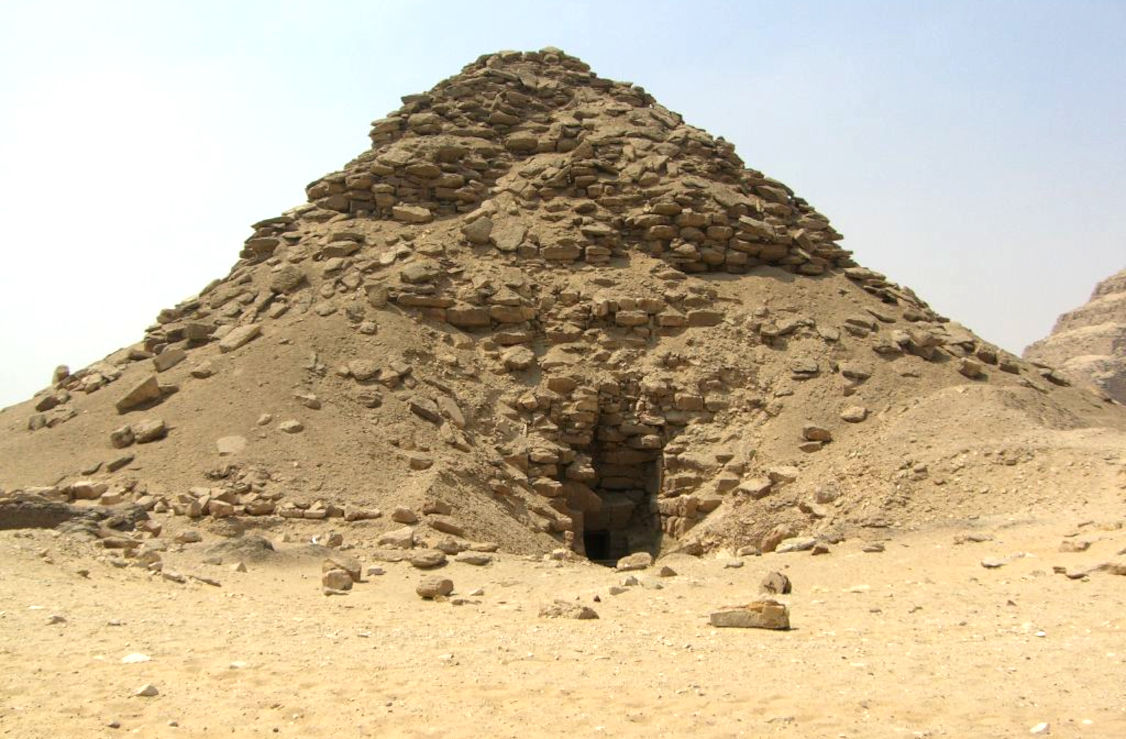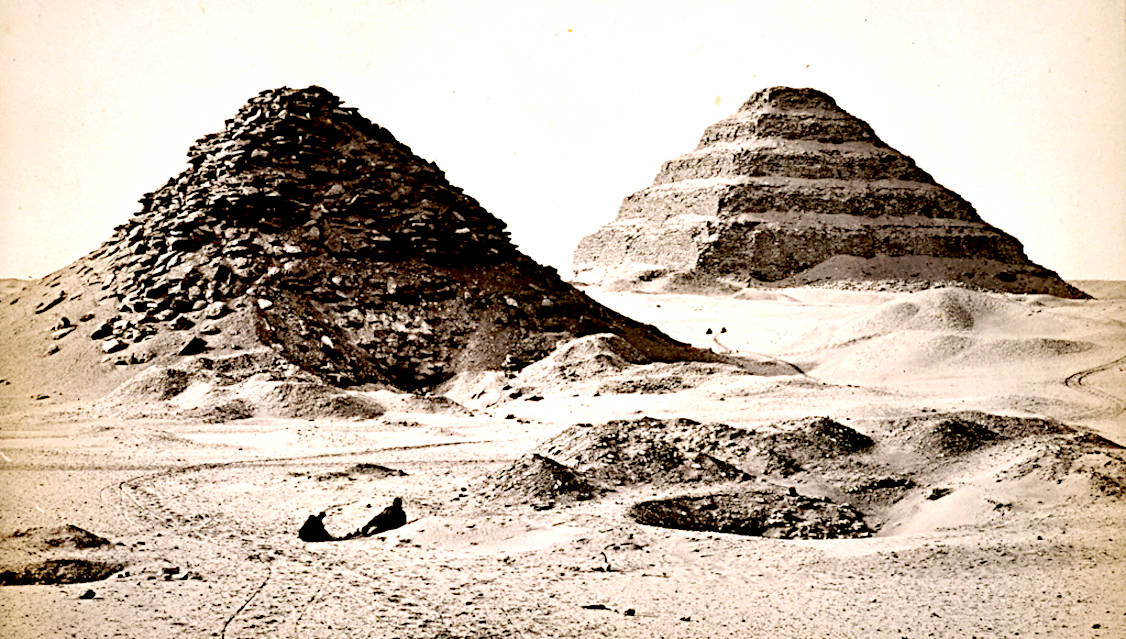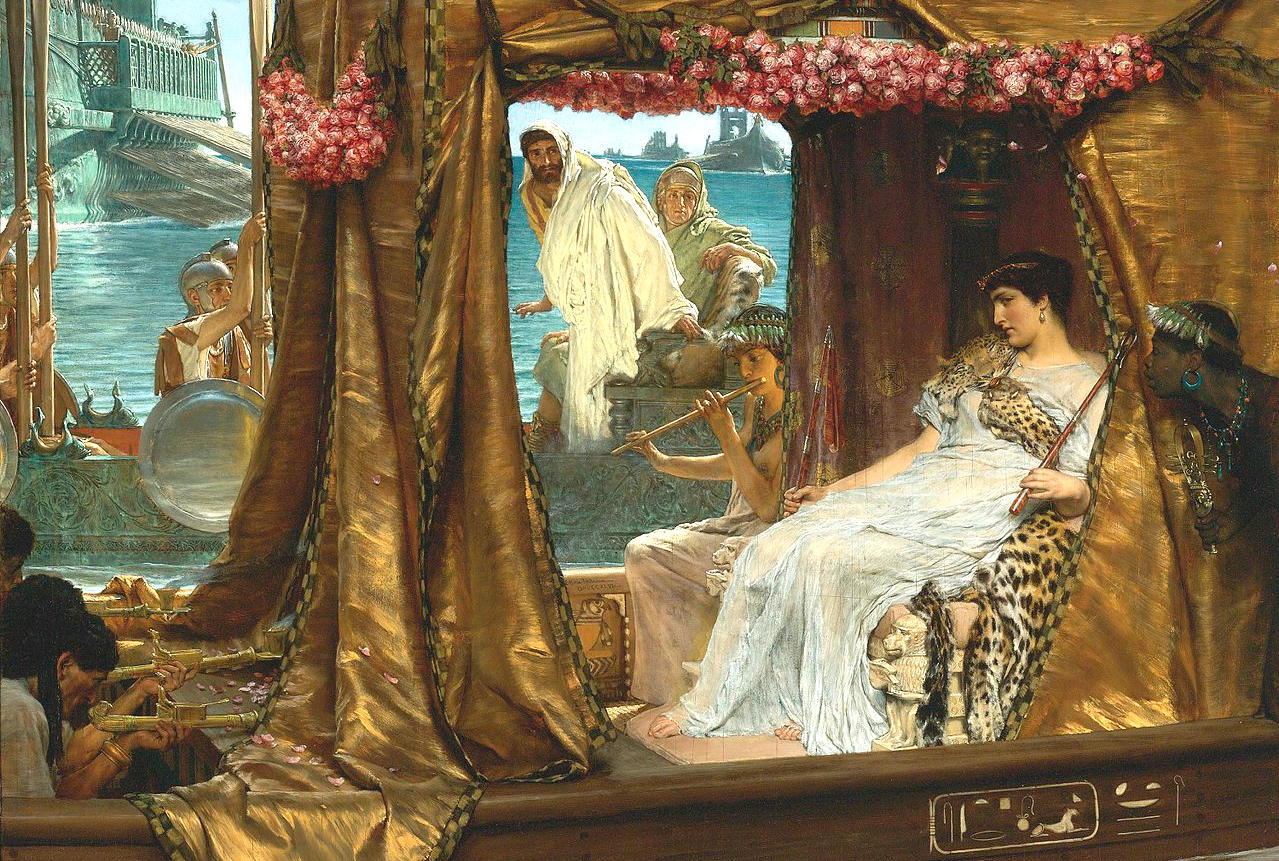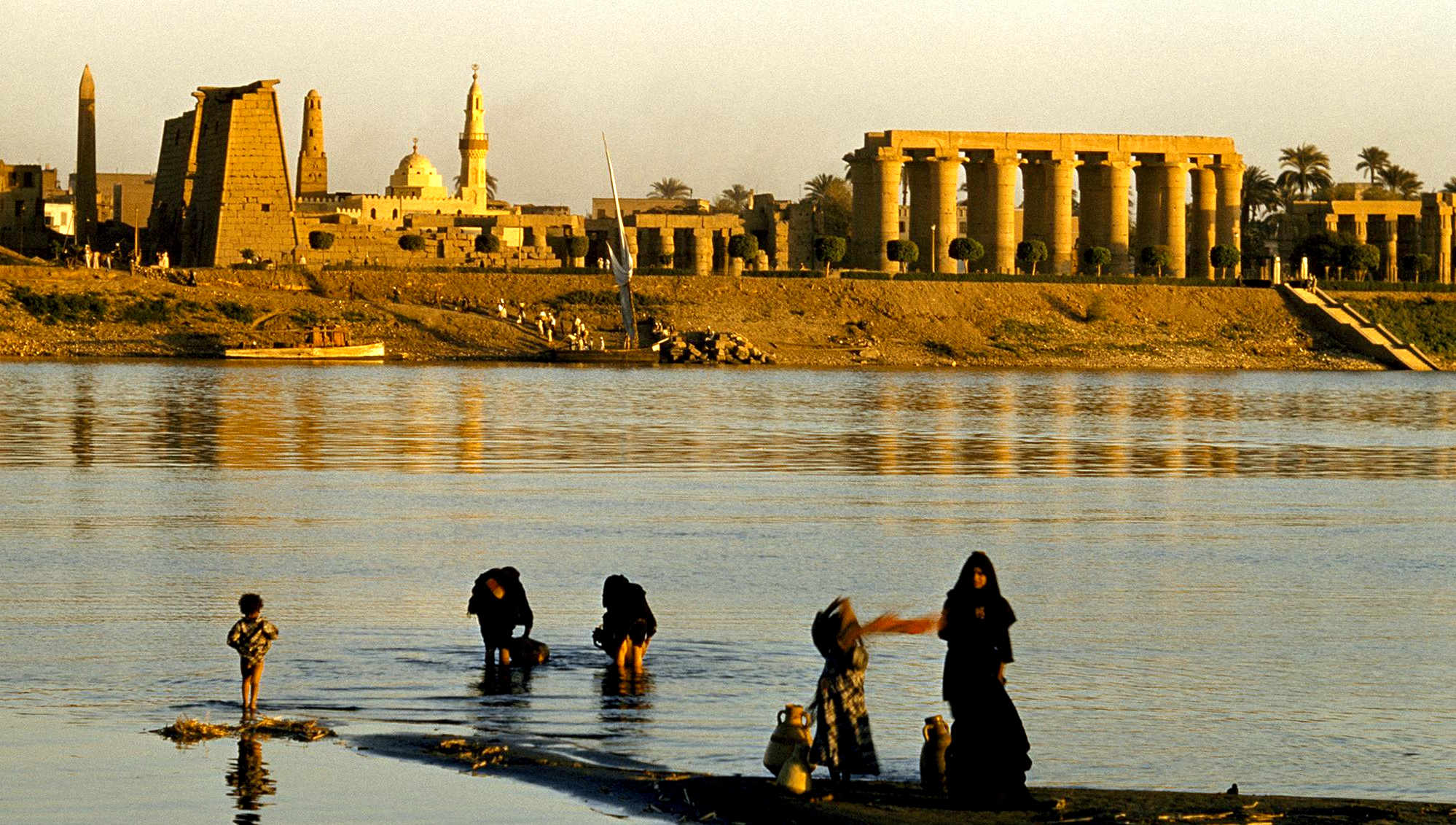
Userkaf's
Pyramid at Saqqara, is the seventh tallest in
Egypt. The pyramid complex was built c. 2490 BC for the pharaoh Userkaf (reigned 2494–2487 BC), founder of the 5th Dynasty of Egypt (c. 2494–2345 BC). It is located in the pyramid field at Saqqara, on the north-east of the step pyramid of Djoser (reigned c. 2670 BC). Constructed in dressed stone with a core of rubble, the pyramid is now ruined and resembles a conical hill in the sands of Saqqara. For this reason, it is known locally as El-Haram el-Maharbish, the "Heap of Stone", and was recognized as a royal pyramid by western archaeologists in the 19th century.
Userkaf's pyramid is part of a larger mortuary complex comprising a mortuary temple, an offering chapel and a cult pyramid as well as separate pyramid and mortuary temple for Userkaf's wife, queen Neferhetepes. Userkaf's mortuary temple and cult pyramid are today completely ruined and difficult to recognize. The pyramid of the queen is no more than a mound of rubble, with its funerary chamber exposed by stone robbers.
The complex is markedly different from those built during the 4th Dynasty (c. 2613–2494 BC) in its size, architecture and location, being at Saqqara rather than the Giza Plateau. As such, Userkaf's pyramid complex could be a manifestation of the profound changes in the ideology of kingship that took place between the 4th and 5th dynasties, changes that may have started during the reign of Userkaf's likely immediate predecessor, Shepseskaf. More than 1,200 years after its construction, the pyramid complex was restored under Ramses II. During the much later Saite period (664–525 BC), it was used as a cemetery.
DISCOVERY
The entrance of the pyramid was discovered in 1831 by the Italian Egyptologist Orazio Marucchi but was not entered until 8 years later in 1839 by John Shae Perring, who took advantage of an existing tunnel dug into the pyramid by tomb robbers. Perring did not know for sure who the owner of the pyramid was and attributed it to Djedkare Isesi (reign 2414–2375 BC), a late 5th dynasty pharaoh. After his investigations Perring buried the robbers tunnel which remains inaccessible to this day. The pyramid of Userkaf entered the official records a few years later in 1842 when Karl Richard Lepsius catalogued it in his list of pyramids under number XXXI. Since Perring had already buried the robbers tunnel by that time, K. R. Lepsius did not investigate the pyramid any further.
The pyramid was then neglected until October 1927, when Cecil Mallaby Firth and the architect Jean-Philippe Lauer started excavating there. During the first season of excavation, Firth and Lauer cleared the south side of the pyramid area, discovering Userkaf's mortuary temple and tombs of the much later Saite period. The following year, Firth and Lauer uncovered a limestone relief slab and a colossal red granite head of Userkaf, thus determining that he was the pyramid owner. After Firth's death in 1931 no excavations took place on site until they were resumed by Lauer in 1948. Lauer worked there until 1955, re-clearing and re-planning the mortuary temple and investigating the eastern side of the pyramid. Research on the north and west sides of the mortuary complex was conducted starting in 1976 by Ahmed el-Khouli who excavated and restored the pyramid entrance. The entrance was, however, buried under rubble in an earthquake in 1991. More recent work on the pyramid was undertaken by Audran Labrousse in 2000.

CONSTRUCTION
Userkaf's pyramid is located on the northeast corner of Djoser's step pyramid complex. The pyramid was originally around 49 metres (161 ft) high and 73 metres (240 ft) large with an inclination of 53° identical to that of Khufu's great pyramid for a total volume of 87,906 m3 (114,977 cu yd). The core of the pyramid is built of small, roughly-hewn blocks of local limestone disposed in horizontal layers. This meant a considerable saving of labor as compared to the large and more accurately-hewn stone cores of 4th Dynasty pyramids. However, as the outer casing of Userkaf's pyramid fell victim to stone robbers throughout the millennia, the loosely assembled core material was progressively exposed and fared much worse over time than that of the older pyramids. This explains the current ruined state of the pyramid.
The pyramid core was constructed in a step-like structure, a construction technique similar to that of the 4th dynasty although the building material was of a significantly lower quality. The outer casing of the pyramid was made of fine Tura limestone which certainly ensured Userkaf's construction an appearance similar to that of the glorious 4th Dynasty pyramids. There was however no red granite paneling over the lower part of the pyramid as in the case of the Pyramid of Menkaure.
The pyramid does not have internal chambers, the chambers being located underground. These were constructed in a deep open ditch dug before the pyramid construction started and only later covered by the pyramid. The entrance to the underground chambers is located north of the pyramid from a pavement in the court in front of the pyramid face. This is different from the 4th dynasty pyramids for which the entrance to the internal chambers is located on the pyramid side itself. The entrance was hewn into the bedrock and floored and roofed with large slabs of white limestone, most of which have been removed in modern times.
From the entrance a 18.5 metres (61 ft) long, southward descending passage leads to a horizontal tunnel some 8 metres (26 ft) below the pyramid base. The first few meters of this tunnel were roofed and floored with red granite. The tunnel was blocked by two large portcullis of red granite, the first one still having traces of the gypsum plaster used to seal the portcullis.
Behind the granite barrier the corridor branches eastward to a T-shaped magazine chamber which probably contained Userkaf's funerary equipment. The presence of such a magazine chamber, located under the base of a pyramid, is unique of all the 5th and 6th dynasty pyramids.
At the south end of corridor lies an antechamber, which is located directly under the tip of the pyramid. The antechamber is oriented on the east–west axis and leads west to the king's burial chamber. The burial chamber has the same height and width as the antechamber, but is longer. At the western end of the burial chamber Perring discovered some fragments of an empty and undecorated black basalt sarcophagus which had been originally placed in a slight depression as well as a canopic chest. The chambers are protected from the pyramid weight by a gabled ceiling made of two large Tura limestone blocks, an architecture common to all pyramids of the 5th and 6th dynasties. The chambers are lined with the same material, while the floor pavement was lost to stone robbers.
MORTUARY TEMPLE
Userkaf's mortuary temple layout and architecture is difficult to establish with certainty. Not only was it extensively quarried for stone throughout the millennia, but a large Saite period shaft tomb was also dug in its midst, damaging it.
Modern reconstructions of the temple nonetheless show that it shared the same elements as all mortuary temples since the time of Khafre (reigned c. 2570 BC). However, just as with the complex, the layout of the temple seem to differ significantly from those of Userkaf's predecessors. The causeway entered the pyramid enclosure at the southern end of the east wall. There the entrance corridor branched south to five magazine rooms as well as a stairway to a roof terrace. To the north a doorway led to a vestibule and then to an entrance hall. That in turn led to an open black-basalt floored courtyard bordered on all sides but the south one by monolithic red granite pillars bearing the titles of the king. A colossal head of Userkaf was found there, the second oldest monumental statue of an Egyptian ruler after the Great Sphinx, now in the Egyptian Museum. The head, which must have belonged to a 5-metre-high (16 ft) statue, represents Userkaf wearing the Nemes and Uraeus. The walls of the courtyard were adorned with fine reliefs of high workmanship depicting scenes of life in a papyrus thicket, a boat with its crew and names of Upper and Lower Egyptian estates connected to the cult of the king.
Two doors at the south-east and south-west corners of the courtyard led to a small hypostyle hall with four pairs of red granite pillars. Beyond were storage chambers and the inner sanctum with three (Ricke) or five (Lauer) statue niches where statues of the king would have been placed, facing the pyramid to the north. Contrary to other mortuary temples, the inner sanctum was thus separated from the pyramid by the courtyard. The only remains of the mortuary temple that are visible today are its basalt paving and the large granite blocks framing the outer door.
Apart
from ruling their country, the
ancient Egyptians
had time to contemplate how they would cope in the afterlife
during the flooding of the Nile, when farm laborers could be
used to build, giving them a positive agenda. Each
successive ruler of the sandy kingdom, wished for more
comforts, and to outdo their forebears, in terms of how they
would be remembered.
Egypt was one of the richest and most powerful civilizations in the world
at that time. So could afford to convert their national
output, into something tangible, for their citizens to
marvel at. At the time they had few threats to national
security.

Generally,
the bigger the pyramid, the more important the Pharaoh. It's
a Freudian thing. This compendium is in order of height.
There are many very interesting pyramid designs that will be
covered in the general indexing, if they have unusual or
developmental features. Since, the art of pyramid
construction and development appears to have been an ongoing
thing, until it fizzled out as a result of resource scarcities, adventures of thieves, and land grants
to priests, as the last straw that broke the camel’s back.
Pyramids ceased to be economically viable, and a huge drain
on what we'd call the Gross National Product (GNP) today.
And as for climate
change, they are hardly a sustainable practice, in UN
SDG terms.
On
the basis that the
taller the pyramid, the higher the status of the
king or queen,
it might be argued that Khufu takes first prize, with Khafre
a close second. After that, nobody came close to 140 meters,
as the national goal to achieve a taller building than the
last ruler fell by the wayside.
Please
note, this is not a definitive table, but our own guide,
based on freely available information. Students of
archaeology and Egyptologists will draw their own
conclusions. Observations are most welcome, if we have
misquoted anything. We'd be pleased to make corrections as
applicable.

RULER
WITHOUT A PYRAMID - Tragically, queen Cleopatra poisoned herself
with an Egyptian cobra. Later her
mausoleum was washed into the sea by an earthquake and
tsunami in 365AD. Leaving little to visibly remind us of
the great Pharaoh.
The oldest known pyramid in Egypt was built around 2630 B.C. at Saqqara, for the third dynasty’s King Djoser. Known as the Step Pyramid, it began as a traditional mastaba but grew into something much more ambitious. The pyramid’s architect was Imhotep, a priest and healer who some 1,400 years later would be deified as the patron saint of scribes and physicians. Over the course of Djoser’s nearly 20-year reign, pyramid builders assembled six stepped layers of stone (as opposed to mud-brick, like most earlier tombs) that eventually reached a height of 204 feet (62 meters); it was the tallest building of its time. The Step Pyramid was surrounded by a complex of courtyards, temples and shrines where Djoser could enjoy his afterlife.
After Djoser, the stepped pyramid became the norm for royal burials, although none of those planned by his dynastic successors were completed (probably due to their relatively short reigns). The earliest tomb constructed as a “true” (smooth-sided, not stepped) pyramid was the Red Pyramid at Dahshur, one of three burial structures built for the first king of the fourth dynasty, Sneferu (2613-2589 B.C.) It was named for the color of the limestone blocks used to construct the pyramid’s core.
